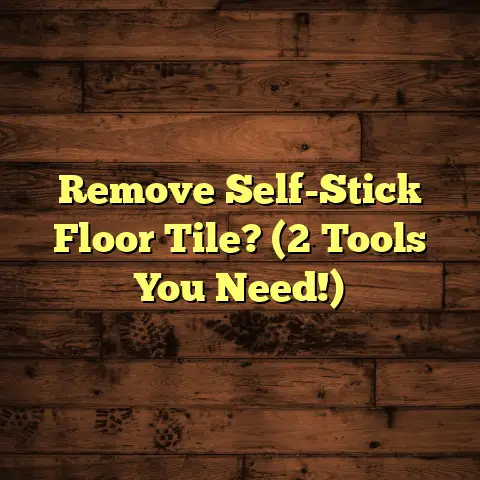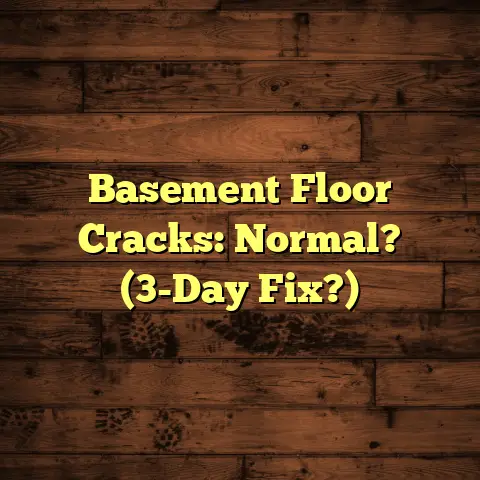Soft Spot Under Laminate? (2 Quick Fixes!)
I’m Mike, your friendly neighborhood flooring contractor.
And let’s be honest, having pets is the best.
The cuddles, the goofy antics, the unconditional love.
But those furry family members can sometimes wreak havoc on our homes, especially our floors.
I’ve seen it all, from excited puppy scratches to, well, let’s just call them “accidents.”
One of the most common issues I encounter is soft spots under laminate flooring.
It’s that sinking feeling (literally!) when you step on a spot and the floor gives way.
It’s not just annoying, it can also be a sign of bigger problems lurking beneath the surface.
These soft spots can be a real pain, right?
They can make your floor look uneven, feel unsafe, and even lead to more extensive damage if left unchecked.
But don’t worry, I’m here to help!
I’m going to share two quick fixes that can get your laminate flooring back in tip-top shape.
These aren’t miracle cures, but they’re effective solutions that can save you time, money, and a whole lot of frustration.
So, grab a cup of coffee (or tea, if that’s your thing), and let’s dive in!
Section 1: Understanding the Causes of Soft Spots Under Laminate
Okay, before we start fixing things, it’s important to understand why these soft spots appear in the first place.
Especially in homes with our beloved pets.
Trust me, knowing the “why” makes the “how” much easier.
Moisture Mayhem:
One of the biggest culprits, especially with pets around, is moisture.
Think about it: accidents happen.
Even the most well-trained pets can have occasional mishaps.
And when that liquid seeps into the seams of your laminate, it can cause the core to swell.
This swelling leads to that dreaded soft spot.
I’ve seen cases where a seemingly small spill has caused significant damage.
According to the Institute of Inspection, Cleaning and Restoration Certification (IICRC), porous materials like wood flooring can absorb moisture within minutes, leading to potential damage and microbial growth if not properly addressed.
The Weight of the World (or at Least a Dog Crate):
Heavy furniture and pet-related equipment can also contribute to soft spots.
Think about that massive dog crate, the overflowing litter box, or even just a favorite napping spot.
Over time, the constant pressure can compress the underlayment and weaken the laminate itself.
I once had a client who couldn’t figure out why a soft spot was developing under their cat’s scratching post.
Turns out, the post was putting all its weight on a single point, causing the laminate to compress over time.
Installation Issues:
Sometimes, the problem isn’t your pet’s fault at all.
Improper installation can also lead to soft spots.
If the subfloor isn’t level, or if the laminate planks aren’t properly locked together, it can create weak points that are prone to softening.
I’ve seen cases where installers skipped crucial steps like using a moisture barrier, which made the floor vulnerable to water damage from the get-go.
The Pet Factor:
Let’s face it, pets are active!
They run, they jump, they scratch.
All that activity can put extra stress on your laminate flooring, especially in high-traffic areas.
I’ve seen scratches that have allowed moisture to seep in, leading to swelling and soft spots.
It’s like a tiny crack in a dam, eventually, it will cause issues.
Here’s a little anecdote from my own experience:
My golden retriever, Max, loves to greet me at the door with a full-body wiggle.
Adorable, right?
But all that wiggling put a lot of stress on the laminate near the entryway, and sure enough, a soft spot started to develop.
I had to reinforce the area with a rug and some extra padding to prevent further damage.
Understanding the Layers:
To really grasp why soft spots form, it helps to understand the layers of laminate flooring:
- Wear Layer: This is the top layer that protects against scratches and stains.
- Decorative Layer: This is the layer that gives the laminate its wood-like appearance.
- Core Layer: This is the main structural component, usually made of high-density fiberboard (HDF) or medium-density fiberboard (MDF). This is the layer most susceptible to moisture damage.
- Backing Layer: This layer provides stability and helps prevent moisture from seeping in from below.
When moisture penetrates the wear layer and reaches the core layer, it can cause the core to swell and lose its structural integrity.
This is what leads to the soft spot.
So, now that we know what causes these pesky soft spots, let’s get to the good stuff: fixing them!
Section 2: Quick Fix #1: Repairing Minor Soft Spots
Alright, let’s tackle those minor soft spots.
This fix is perfect for those small, localized areas where the laminate feels a little spongy but isn’t severely damaged.
Think of it as a quick patch-up job that can buy you some time and prevent further damage.
Assessing the Damage:
Before you grab your tools, take a good look at the soft spot.
- How big is it? Is it a small area, or is it spreading?
- How soft is it? Does it feel slightly spongy, or does it sink in significantly when you step on it?
- Is there any visible damage? Are there any cracks, chips, or signs of swelling?
If the soft spot is small, localized, and doesn’t show any major damage, then this quick fix should do the trick.
However, if the soft spot is large, widespread, or shows signs of significant damage, you might need to move on to Quick Fix #2 or call in a professional (that’s me!).
Gathering Your Supplies:
For this fix, you’ll need a few basic supplies:
- Wood Filler or Laminate Repair Kit: I recommend using a laminate repair kit specifically designed for laminate flooring. These kits usually come with a variety of colors that you can mix to match your flooring. Wood filler can also work, but it might be harder to match the color perfectly. You can find these kits at most home improvement stores like Home Depot or Lowe’s, or online at Amazon.
- Putty Knife or Spreader: This will help you apply the filler smoothly and evenly.
- Sandpaper (Fine-Grit): For smoothing out the filled area.
- Cleaning Supplies: A damp cloth and some mild detergent.
- Color-Matching Marker or Stain (Optional): For blending the repair with the surrounding flooring.
- Sealer (Optional): To protect the repaired area from moisture.
Step-by-Step Repair Process:
-
Clean the Area: Start by cleaning the area around the soft spot with a damp cloth and some mild detergent. Remove any dirt, dust, or debris. Make sure the area is completely dry before proceeding.
-
Apply the Filler: Using your putty knife or spreader, carefully apply the wood filler or laminate repair compound to the soft spot. Fill the area completely, making sure to press the filler into any cracks or crevices. Overfill the area slightly, as the filler will shrink as it dries.
-
Allow to Dry: Follow the manufacturer’s instructions for drying time. This can vary depending on the type of filler you use, but it’s usually around 24 hours.
-
Sand the Area: Once the filler is completely dry, use fine-grit sandpaper to smooth out the area. Sand gently, blending the filler with the surrounding flooring. Be careful not to scratch the surrounding laminate.
-
Color Matching (Optional): If the filler doesn’t perfectly match your flooring, use a color-matching marker or stain to blend it in. Apply the marker or stain sparingly, and wipe off any excess with a clean cloth.
-
Apply Sealant (Optional): To protect the repaired area from moisture, apply a sealant specifically designed for laminate flooring. This is especially important if the soft spot was caused by moisture damage.
Tips and Tricks:
- Color Matching is Key: Take your time to find a filler or repair compound that closely matches your flooring. You can even mix different colors together to get the perfect match.
- Don’t Overfill: It’s better to underfill the area slightly than to overfill it. You can always add more filler if needed.
- Sand Gently: Sanding too aggressively can damage the surrounding laminate. Use a light touch and fine-grit sandpaper.
- Consider a Template: For larger repairs, you can use a template to help you create a smooth, even surface.
- Prevention is Better Than Cure: Once you’ve repaired the soft spot, take steps to prevent it from happening again. Use rugs in high-traffic areas, clean up spills immediately, and make sure your pets are properly trained.
I’ve had clients who were amazed at how well this simple fix worked.
One woman had a small soft spot near her dog’s water bowl.
She followed these steps, and you couldn’t even tell there had ever been a problem.
It saved her the hassle and expense of replacing the entire floor!
Remember, this fix is best for minor soft spots.
If the damage is more extensive, you’ll need to move on to Quick Fix #2.
Section 3: Quick Fix #2: Addressing Larger Soft Spots or Structural Issues
Okay, so Quick Fix #1 wasn’t enough?
That’s alright.
Some soft spots require a more comprehensive approach.
This fix is for those larger areas or when you suspect there might be structural issues underneath the laminate.
This might sound intimidating, but trust me, with a little patience and the right tools, you can tackle this yourself.
Identifying the Root Cause:
Before you start ripping up your floor, it’s crucial to figure out why the soft spot is there in the first place.
Is it still moisture? Is it a damaged subfloor? Is it simply wear and tear?
Knowing the cause will help you prevent the problem from recurring.
If you suspect moisture, check for leaks around windows, doors, or pipes.
If the subfloor is damaged, you’ll need to repair or replace it before installing new laminate.
Gathering Your Supplies:
For this fix, you’ll need a few more tools and materials:
- Pry Bar or Laminate Flooring Removal Tool: This will help you lift the laminate planks without damaging them.
- Replacement Laminate Planks: Make sure you get the exact same type and color as your existing flooring. It’s always a good idea to buy a little extra, just in case.
- Moisture Meter: To check the moisture levels in the subfloor.
- Level: To ensure the subfloor is level before installing new laminate.
- Circular Saw or Hand Saw: For cutting replacement planks to size.
- Tapping Block and Hammer: For locking the new planks into place.
- Construction Adhesive (Optional): For extra security, especially in high-traffic areas.
- Moisture Barrier (If Needed): To protect the subfloor from moisture.
- Safety Glasses and Gloves: To protect yourself from dust and debris.
Step-by-Step Repair Process:
-
Remove the Affected Planks: Using your pry bar or laminate flooring removal tool, carefully lift the planks around the soft spot. Start at the edge of the room and work your way towards the center. Be gentle, and try not to damage the planks. If the planks are glued down, you might need to use a heat gun to soften the adhesive.
-
Inspect the Subfloor: Once you’ve removed the planks, inspect the subfloor for damage. Look for signs of moisture, mold, or rot. If the subfloor is damaged, you’ll need to repair or replace it before proceeding. Use a moisture meter to check the moisture levels in the subfloor. According to the National Wood Flooring Association (NWFA), the moisture content of the subfloor should be within 2% of the moisture content of the wood flooring.
-
Address Moisture Issues: If you find signs of moisture, address the source of the moisture and allow the subfloor to dry completely. You can use a dehumidifier or fans to speed up the drying process. If the moisture damage is extensive, you might need to replace the affected section of the subfloor.
-
Prepare the Subfloor: Make sure the subfloor is clean, level, and dry. Use a level to check for any unevenness. If necessary, use a self-leveling compound to level the subfloor.
-
Install a Moisture Barrier (If Needed): If you’re concerned about moisture, install a moisture barrier over the subfloor. This will help protect the laminate from moisture damage.
-
Cut the Replacement Planks: Measure the area where you need to install the replacement planks. Use a circular saw or hand saw to cut the planks to the correct size.
-
Install the New Planks: Starting at one edge of the room, install the new planks according to the manufacturer’s instructions. Use a tapping block and hammer to lock the planks into place. If desired, apply construction adhesive to the back of the planks for extra security.
-
Clean Up: Once you’ve installed the new planks, clean up any dust or debris.
Preventative Measures:
- Use Area Rugs: Place area rugs in high-traffic areas to protect the laminate from wear and tear.
- Clean Up Spills Immediately: Wipe up spills as soon as they happen to prevent moisture from seeping into the laminate.
- Use Moisture Barriers: Install moisture barriers in areas that are prone to moisture, such as bathrooms and kitchens.
- Train Your Pets: Train your pets to avoid scratching or urinating on the floor.
- Regularly Inspect Your Flooring: Check your flooring regularly for signs of damage, such as soft spots, cracks, or swelling.
I remember one client who had a major soft spot in their living room.
Turns out, a leaky pipe had been dripping water onto the subfloor for months.
We had to replace a large section of the subfloor and install new laminate.
It was a lot of work, but the end result was a beautiful, solid floor that they could enjoy for years to come.
This fix is more involved than Quick Fix #1, but it’s essential for addressing larger soft spots and structural issues.
Don’t be afraid to tackle this yourself, but if you’re not comfortable with any of these steps, don’t hesitate to call a professional.
Conclusion
So, there you have it: two quick fixes for those annoying soft spots under your laminate flooring.
I hope this article has given you the confidence to tackle these issues yourself and save some money in the process.
Remember, maintaining your laminate flooring is crucial, especially in homes with pets.
Regular cleaning, prompt repairs, and preventative measures can go a long way in extending the life of your floor.
And let’s be honest, a well-maintained home is a happy home, for both you and your furry friends.
I always tell my clients that a little bit of effort can save them a lot of headaches down the road.
Think of it as an investment in your home and your peace of mind.
I know it can be frustrating to deal with flooring issues, but don’t let it get you down.
Pets bring so much joy to our lives, and a few soft spots are a small price to pay for their companionship.
With a little bit of knowledge and some elbow grease, you can keep your floors looking great and enjoy your pets for years to come.
So, go forth and conquer those soft spots!
You’ve got this!
And if you ever need a helping hand, you know where to find me.
Happy flooring!





